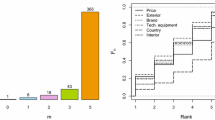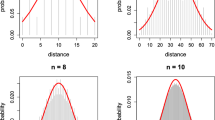Abstract
Multistage ranking models, including the popular Plackett–Luce distribution (PL), rely on the assumption that the ranking process is performed sequentially, by assigning the positions from the top to the bottom one (forward order). A recent contribution to the ranking literature relaxed this assumption with the addition of the discrete-valued reference order parameter, yielding the novel Extended Plackett–Luce model (EPL). Inference on the EPL and its generalization into a finite mixture framework was originally addressed from the frequentist perspective. In this work, we propose the Bayesian estimation of the EPL in order to address more directly and efficiently the inference on the additional discrete-valued parameter and the assessment of its estimation uncertainty, possibly uncovering potential idiosyncratic drivers in the formation of preferences. We overcome initial difficulties in employing a standard Gibbs sampling strategy to approximate the posterior distribution of the EPL by combining the data augmentation procedure and the conjugacy of the Gamma prior distribution with a tuned joint Metropolis–Hastings algorithm within Gibbs. The effectiveness and usefulness of the proposal is illustrated with applications to simulated and real datasets.



Similar content being viewed by others
References
Alvo M, Yu PL (2014) Statistical methods for ranking data. Springer, New York
Caron F, Doucet A (2012) Efficient Bayesian inference for generalized Bradley–Terry models. J Comput Graph Stat 21(1):174–196
Critchlow DE, Fligner MA, Verducci JS (1991) Probability models on rankings. J Math Psychol 35(3):294–318
Gormley IC, Murphy TB (2006) Analysis of Irish third-level college applications data. J R Stat Soc A 169(2):361–379
Henery RJ (1981) Permutation probabilities as models for horse races. J R Stat Soc B 43(1):86–91
Jacques J, Grimonprez Q, Biernacki C (2014) Rankcluster: an R package for clustering multivariate partial rankings. R J 6(1):101–110
Kamishima T (2003) Nantonac collaborative filtering: recommendation based on order responses. In: Proceedings of the ninth ACM SIGKDD international conference on knowledge discovery and data mining, ACM, pp 583–588
Liu Q, Crispino M, Scheel I, Vitelli V, Frigessi A (2019) Model-based learning from preference data. Annu Rev Stat Appl 6:329–354
Luce RD (1959) Individual choice behavior: a theoretical analysis. Wiley, New York
Marden JI (1995) Analyzing and modeling rank data. Monographs on statistics and applied probability, vol 64. Chapman & Hall, New York
Mollica C, Tardella L (2014) Epitope profiling via mixture modeling of ranked data. Stat Med 33(21):3738–3758
Mollica C, Tardella L (2017) Bayesian mixture of Plackett–Luce models for partially ranked data. Psychometrika 82(2):442–458
Plackett RL (1975) The analysis of permutations. J R Stat Soc C 24(2):193–202
Spiegelhalter DJ, Best NG, Carlin BP, Van Der Linde A (2002) Bayesian measures of model complexity and fit. J R Stat Soc B 64(4):583–639
Stern H (1990) Models for distributions on permutations. J Am Stat Assoc 85(410):558–564
Tierney L (1994) Markov chains for exploring posterior distributions. Ann Stat 22(4):1701–1762
Vigneau E, Courcoux P, Semenou M (1999) Analysis of ranked preference data using latent class models. Food Qual Prefer 10(3):201–207
Vitelli V, Sørensen Ø, Crispino M, Frigessi A, Arjas E (2018) Probabilistic preference learning with the Mallows rank model. J Mach Learn Res 18(158):1–49
Yu PLH, Lam KF, Lo SM (2005) Factor analysis for ranked data with application to a job selection attitude survey. J R Stat Soc A 168(3):583–597
Acknowledgements
We are deeply grateful to both anonymous referees, whose comments and suggestions allowed us to improve the article. This work has been supported by Sapienza Università di Roma, Grant RP11816436B15B6B.
Author information
Authors and Affiliations
Corresponding author
Additional information
Publisher's Note
Springer Nature remains neutral with regard to jurisdictional claims in published maps and institutional affiliations.
Electronic supplementary material
Below is the link to the electronic supplementary material.
Appendix
Appendix
1.1 An example of EPL model
Here is a simple example to clarify the EPL formulation introduced in (1). Without loss of generality, let us suppose that an \(\text {EPL}(\dot{\rho },\underline{\dot{p}})\) with parameter values \(\dot{\rho }=(4,1,3,2)\) and \(\underline{\dot{p}}=(0.4,0.3,0.2,0.1)\) represents the true data generating mechanism. Under this EPL scenario, the positions are assigned according to an alternating preference scheme: the item selected at the first stage corresponds to the least-liked alternative (\(\dot{\rho }(1)=4\)); at the second stage, the most-liked item is specified (\(\dot{\rho }(2)=1\)); the item ranked at the third stage is the one receiving the third position (\(\dot{\rho }(3)=3\)) and, finally, the remaining alternative of the forth stage is placed second in order of preference (\(\dot{\rho }(4)=2\)). Regarding the support parameters, they reflect a decreasing first-stage choice probability such that \({\dot{p}}_i\propto (K+1)-i\). Hence, the chance of being ranked last reduces when proceeding from alternative 1 up to alternative 4: item 1 is more likely to be chosen at the first step and, thus, to be ranked last, followed in the order by item 2, 3 and 4.
Since the rank assignment order \(\rho\) is not restricted to the identity permutation \(\rho _{\text {F}}\) as in the PL, a generic ordering \(\pi ^{-1}\) does not coincide with the sequence \(\eta ^{-1}=\pi ^{-1}\circ \rho\) listing the items selected at each stage of the ranking process. For example, the considered \(\text {EPL}(\dot{\rho },\underline{\dot{p}})\) implies that observing the ordering \(\pi ^{-1}=(3,1,4,2)\) corresponds to the sequential item selections indicated by the composition below
that is, one chooses item 2 at the first stage, item 3 at the second stage, item 4 at the third stage and item 1 at the last stage.
Equation (1) states that the probability mass associated to \(\pi ^{-1}=(3,1,4,2)\) under the specified \(\text {EPL}(\dot{\rho },\underline{\dot{p}})\) can be computed from the PL distribution after rearranging the components of \(\pi ^{-1}\) according the reference order \(\dot{\rho }\):
Rights and permissions
About this article
Cite this article
Mollica, C., Tardella, L. Bayesian analysis of ranking data with the Extended Plackett–Luce model. Stat Methods Appl 30, 175–194 (2021). https://doi.org/10.1007/s10260-020-00519-5
Accepted:
Published:
Issue Date:
DOI: https://doi.org/10.1007/s10260-020-00519-5




